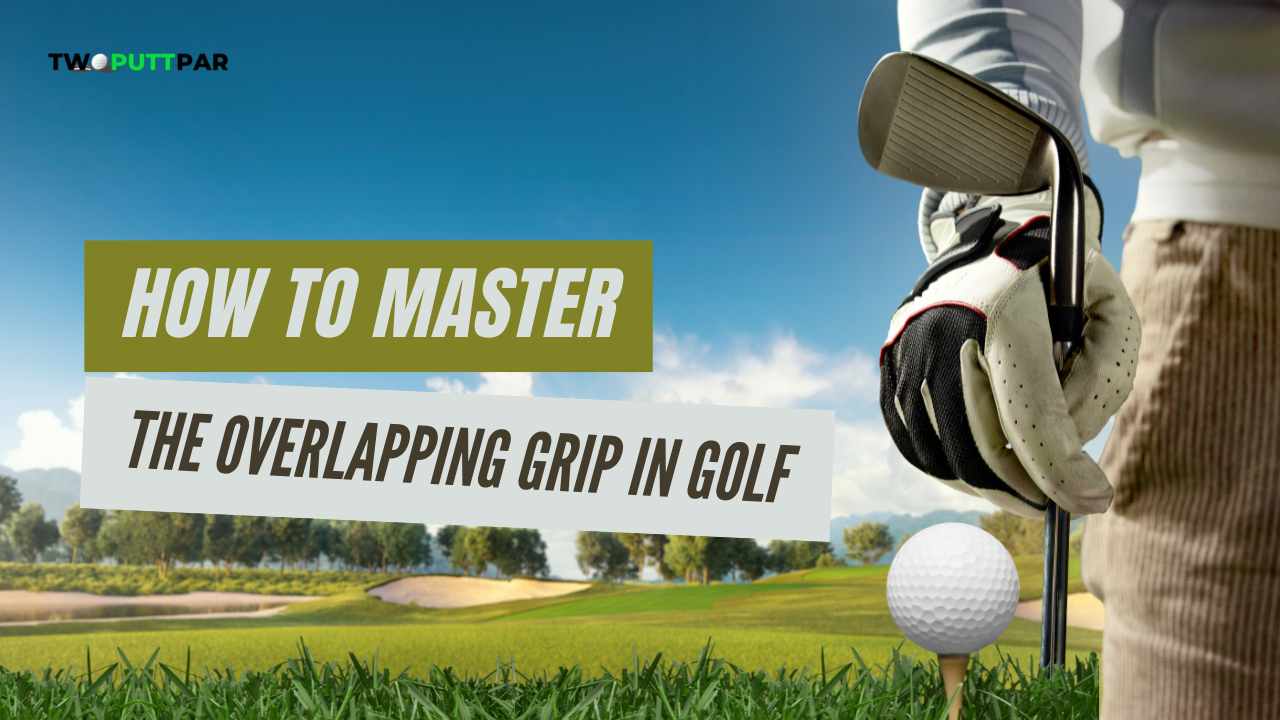
Mid-Handicap golfer who loves to share his rounds and experiences playing courses all around the UK in a hope that it will help others find those hidden gem golf courses.
I seek out golf courses that don’t get the credit they deserve and are often overlooked for the bigger more well known ones.
The overlapping grip, also known as the Vardon grip, is a popular technique used by professional golfers because of its many advantages.
In this post, we will discuss the benefits of using an overlapping grip in your golf swing and provide step-by-step instructions on how to properly execute it.
To master the overlapping grip in golf, it’s crucial to place the little finger of your right hand between the index and middle fingers of your left hand, ensuring they overlap as depicted in various golf instruction sources.
What Is Overlapping Grip
The overlapping grip, also known as the Vardon Grip, is a method of holding the golf club where the little finger of your right hand interlocks or overlaps with the index and middle fingers of your left hand, if you’re a right-handed golfer.
The overlapping grip is named after Harry Vardon, a professional golfer from Jersey, who popularised this technique during the late 19th and early 20th centuries.
This grip technique is favoured by most professional golfers due to its balance of control and power.
To correctly implement the overlapping grip, place your hands on the golf club handle, aligning your thumbs with the club’s shaft.
The little finger of your right hand should fit snugly between the index and middle finger of your left hand. Ensure your grip is firm but relaxed to prevent tension in your swing.
The overlapping grip can significantly enhance your game by improving your swing’s control and stability, making it a vital skill for both beginner and advanced golfers to master.
How To Master The Interlocking Grip
Mastering the interlocking grip involves understanding its mechanics, practicing regularly, and making necessary adjustments to ensure comfort and efficiency.
Understand the Mechanics
The first step to mastering the interlocking grip is to understand its mechanics. This grip style involves interlocking the index finger of the left hand with the little finger of the right hand (for right-handed golfers).
The left thumb should rest in the lifeline of the right hand, while the right thumb points down towards the clubhead. It’s important to maintain a consistent grip pressure throughout the swing.

Practice Regularly
Like any new skill in golf, regular practice is key to mastering the interlocking grip. Start by gripping the club with an interlocked grip during your practice sessions, even if it feels uncomfortable at first.
Over time, your hands will get used to this new grip style and it will start to feel more natural.
Make Necessary Adjustments
Not every golfer’s hands are the same size or shape, so you may need to make some adjustments to the standard interlocking grip to make it work for you.
For example, if you have larger hands, you might find it more comfortable to only partially interlock your fingers, or to position your hands slightly higher or lower on the club handle.
Always prioritise comfort and control over strict adherence to the standard grip style.
Get Professional Advice
If you’re struggling to master the interlocking grip, it can be helpful to seek advice from a professional golf coach. They can watch your technique and provide specific feedback and tips to help you improve.
Remember, the goal is to find a grip style that helps you hit accurate, consistent shots, so don’t be afraid to experiment and make changes as needed.
Pros of Using The Interlocking Grip
The interlocking grip offers several advantages such as secure hold, suitability for smaller hands, and improved control for certain players.
Secure Hold
One of the main advantages of the interlocking grip is the secure hold it provides. By interlocking the fingers from both hands, golfers are able to maintain a firm grip on the club throughout their swing.
This can be particularly beneficial for those who struggle with the club slipping or twisting in their hands.
Suitability for Smaller Hands
The interlocking grip is often favoured by players with smaller hands. The interlocking fingers help to create a solid connection between the two hands, which can make it easier for those with smaller hands to maintain control over the club. This is why this grip style is popular among women and junior golfers.
Improved Control
For some players, the interlocking grip can provide improved control over the club.
By locking the hands together, the golfer may feel they have more control over the clubhead throughout the swing. This can lead to increased accuracy, particularly with shorter irons and wedges.
Easier Wrist Action
The interlocking grip can also facilitate easier wrist action for some golfers.
Because the hands are locked together, some players find it easier to achieve the necessary wrist hinge in the backswing and follow through, which can result in a smoother, more efficient swing.
Cons of Using The Interlocking Grip
The interlocking grip, while beneficial for some, can present challenges such as discomfort, reduced power, and lack of control for certain players.
Discomfort
One of the main drawbacks of the interlocking grip is that it can cause discomfort for some golfers. This is particularly true for those with larger hands or those who are not used to interlocking their fingers.
The interlocking grip can also lead to blisters on the webbing between the fingers if not properly managed.
Reduced Power
Another disadvantage of the interlocking grip is that it can potentially reduce power in your swing. This is often noted in players with moderate to slow swing tempos and average ball-striking abilities.
This grip style may limit the wrist hinge, which is a key component of generating power in a golf swing.
Lack of Control
While the interlocking grip can provide a firm hold on the club, it also has the potential to limit control. This is because both hands are equal in this grip style, which can lead to the dominant hand taking over the swing.
This imbalance can affect the swing path and result in less accurate shots.
Grip Pressure
Grip pressure is another area where the interlocking grip can pose challenges. Some golfers might grip the club too tightly, which can lead to a loss of clubhead speed and negatively impact the rhythm and flow of the swing.
Which is Better: Overlapping or Interlocking Grip?
| Overlapping Grip | Interlocking Grip | |
|---|---|---|
| Comfort | Often more comfortable for players with larger hands. | Preferred by players with smaller hands, including women and younger players. |
| Control | Offers a unified control over the club as it forces the hands to work together throughout the swing. | Provides a secure hold on the club, beneficial for those who have issues with the club slipping. |
| Power | Favored for the balance it offers between control and power. | Can lead to gripping the club too tightly, which might affect the power of the swing. |
| Popularity | Favoured by many professional players. | Popular among amateurs, women and young players. |
| Ease of Use | Might be easier to learn for beginners due to its natural feel. | Might take time to get used to, especially if the player has larger hands. |
| Versatility | Suitable for a wide variety of swing styles. | More suitable for players with a specific style that requires a secure grip. |
The choice between the overlapping and interlocking grip in golf often comes down to personal comfort, hand size, swing style, and control needs of individual players.
Overlapping Grip
The overlapping grip, also known as the Vardon grip, is a technique where the little finger of the trailing hand (right hand for right-handed players) rests between the index and middle fingers of the leading hand.
This grip is favoured by many professional players for the balance it offers between control and power.
The overlapping grip forces the hands to work in unison throughout the swing, offering a unified control over the club. Players with larger hands often find this grip more comfortable.
Interlocking Grip
The interlocking grip involves fitting the little finger of the trailing hand between the index and middle fingers of the leading hand, essentially ‘locking’ the two hands together.
This grip is often preferred by players with smaller hands, including women and younger players, as it provides a secure hold on the club.
The interlocking grip is also beneficial for those who have issues with the club slipping in their hands. However, some players find that this grip can lead to gripping the club too tightly, which could negatively affect the fluidity of the swing.
FAQs
Q: What is the difference between the overlapping grip and the interlock grip?
A: The overlapping grip and the interlock grip are two common types of grips in golf. The overlapping grip involves the little finger of the trailing hand overlapping between the index and middle fingers of the lead hand. The interlock grip, on the other hand, involves interlocking the little finger of the trailing hand with the index finger of the lead hand. Both grips have their advantages and disadvantages, and it ultimately comes down to personal preference.
Q: Can I use a baseball grip instead of the overlapping grip?
A: Yes, you can use a baseball grip instead of the overlapping grip in golf. The baseball grip involves placing both hands side by side on the club, similar to how you would grip a baseball bat. While it is less common in golf, some players find it comfortable and effective.
Q: Why is the overlapping grip popular in golf?
A: The overlapping grip is popular in golf because it provides a sense of control and stability in the golf swing. The overlapping of the little finger helps to secure the grip and prevent the club from twisting during the swing. Many professional golfers, including Jack Nicklaus, have used the overlapping grip successfully.
Q: Does the size of my hands affect the overlapping grip?
A: The size of your hands can affect how you grip the club, including the overlapping grip. Golfers with larger hands might find it easier to use the overlapping grip, while those with smaller hands may prefer the interlock grip or another grip style. It’s important to find a grip that feels comfortable and allows for proper control of the golf club.
Q: Is the overlapping grip the best grip to start with for beginners in golf?
A: The overlapping grip is one of the most commonly taught grips in golf and can be a good grip for beginners to start with. However, it’s important for beginners to experiment with different grip styles and find the one that feels most comfortable and allows for proper control of the golf club.
Q: Does the overlapping grip make a difference in my golf swing?
A: Yes, the overlapping grip can make a difference in your golf swing. It helps to provide stability and control throughout the swing, which can lead to more consistent shots. Using the correct grip is an important aspect of a good golf swing.
Q: What are the benefits of using the overlapping grip in golf?
A: The overlapping grip offers several benefits in golf. It promotes a unified grip and helps to prevent the clubface from opening or closing during the swing. This leads to better clubhead control and increased accuracy. Additionally, the overlapping grip can provide a secure and comfortable grip, which enhances overall club control and swing consistency.
Q: Can I use the overlapping grip on the PGA Tour?
A: Yes, many professional golfers on the PGA Tour use the overlapping grip. It is a popular grip among both professional and amateur golfers and is known for its effectiveness in providing stability and control.
In Conclusion
In conclusion, the overlapping grip is a fundamental technique that golfers must master in order to improve their game.
By allowing players to have a stronger and more controlled grip on the club, this grip can help prevent slices and hooks and lead to more accurate shots.
Additionally, mastering the overlapping grip can also provide greater power and distance in a golfer’s swing.
Affiliate Disclaimer – As an affiliate, we may earn a commission from qualifying purchases. We get commissions for purchases made through links on this website from Amazon and other third parties.





Leave a Reply